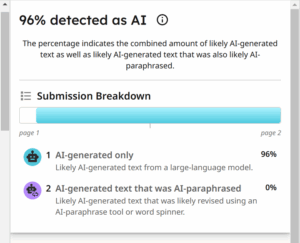Each May, hundreds of thousands of high school students from across the United States take the Advanced Placement exam for English Literature and Composition. Each June, hundreds of high school and college English instructors gather for a week to score them. The three-hour exam consists of two parts: a multiple-choice section and a section with three essays (analyses of poetry and fiction and a literary argument essay).
This year, for the third time, I was one of the essay graders. What follows are my unvarnished thoughts from the week, presented anonymously—because I might want to get invited back to grade again.
Day 1
My plane to Salt Lake City is delayed, so I arrive at my hotel well after midnight. My assigned roommate is fast asleep. We have the option of staying in a single room, but only if we pay half.
The alarm goes off at 7. My roommate and I introduce ourselves as he exits the shower. He is ready to go well before me. He’s a first-timer.
I head over to the convention center. At 8 a.m. sharp, hundreds of us gather in a large auditorium for orientation. The chief reader—a professor at a Baptist college—seems a genial enough person. He goes over the week’s game plan via PowerPoint (“read every essay like it’s your first”), makes sundry bureaucratic announcements and introduces the other managers (“assistant readers,” “table leaders,” etc.). Peals of applause burst out frequently, lending the proceedings a summer camp air. To cap things off, the chief reader puts up photos of his dog.
The reading room—the size of an airplane hangar, with cement floors and high ceilings hung with banks of fluorescent lights—is divided into four or five sections of probably around 100 people each. Each section is enclosed by black curtains supported by metal rods. Readers are grouped eight to a table, each with a laptop.
I admit I’m not in the most chipper mood after the short night’s sleep. The enthusiastic vibe can’t help, either. I grab a cup of free coffee (very low quality), take my seat and introduce myself to the woman seated next to me, a high school teacher from Texas. Then our peppy table leader comes over. “Hi, yeah, sorry, would you mind putting your coffee on the floor? We’re trying to be careful with the laptops.” I sigh and glance around to see other tables with coffee cups and bottles on them. I put my cup on the floor. We spend much of the first day training—watching videos, practicing on sample essays, tuning our brains to AP standards.
Day 2
As I sit in the reading room, time crawls; with no windows it could be 3 in the morning for all I know. The novelty has worn off and the grind has set in. Is this what a real job is like? I improvise a routine to manage the boredom: Along with the scheduled 15-minute breaks in the morning and afternoon, every 30 or 40 minutes I get up to walk around, check my phone, stare into space.
The other readers seem to be mostly high school teachers. They seem well adapted to the AP regimen, and to regimentation. Many wear T-shirts with pro-literacy or pro-reading themes. I’d estimate that about two-thirds of the scorers are women. That fits with the service-heavy load female professors typically shoulder at most universities.
We are served three free meals a day, buffet-style, all you can eat. There’s a strange symmetry with our daily work—all the exams you can score from a never-ending supply. As my waistline expands, I feel my brain shrinking. The buffet lines are staffed by an army of food service workers, mostly Hispanic or Asian, who bring out metal trays and various tureens from mysterious kitchens for our breakfast, lunch and dinner, as well as the coffee and snacks for our scheduled breaks. The working class works for us, the petit bourgeois, as we help classify the next generation as either part of the future lower middle or upper middle class.
As we filter back into the reading room after lunch, the chief reader addresses us over a PA system, thanking us for returning on time, reminding us to score carefully, regaling us with a choice quote or two.
Day 3
I breakfast with my roommate and a few of his reading-table mates. He really is the nicest person. They invite me to karaoke later. A few drinks would be nice, though I can’t fathom singing after this kind of work.
I read (or scan, actually) more than 100 essays per day. On average, one or two offer something insightful or fluent. The rest either scrape by, or don’t. Many in fact are aborted on takeoff—a sentence or two, maybe a phrase, sometimes nothing at all. Probably 10 to 15 percent are these kind of no-show efforts. It makes me wonder why these students take this test. Do they get extra class credit for merely showing up? To quote from a favorite Scorsese movie, “Qui bono?”
I continually hear the crinkling of candy and other snacks—provided free by AP, and replenished daily—being unwrapped. This is in addition to the free, all-you-can-eat meals and snacks during breaks.
The assistant reader hovers around the tables in our section like a wary exam proctor, watching us for who knows what. This afternoon, the third day of the reading, the computers go down. With nothing to do, I pull out my phone and start reading an article on the author of a literary selection our exams are based on. My friendly table leader comes over. “Let’s please put away our phones.” I scoff and return to reading the article. A few minutes later the assistant reader sidles up to me. “Please put away your phone.” Before I can reply she has moved away.
The silent whistle finally blows at 5. We stream out of the reading room and down the long corridors of the convention center like mill workers at the end of the day shift. We enter the dining hall or drift outside into the sunny and warm late afternoon. I head straight to the hotel fitness center, the stress of the day evaporating with each set, recharging for another day, just like my Motorola plugged into the hotel room nightstand.
Later that evening my roommate returns to our room (“karaoke was great!”) and asks me if I want to go tomorrow night. I beg off again (I plead achoraphobia—fear of public singing).
Day 4
Salt Lake City—capital of the Beehive State. At lunch I skip the dining hall and make a beeline outside to get some much-needed air and sun. I make my way to Temple Square, the Mormon Vatican. Groups of tourists mix in with groups of name-tagged believers. The temple itself is swaddled in scaffolding. I watch the giant cranes convey building materials to men 10 stories up. A plaque on the Brigham Young Monument records the names of the original 1847 Mormon pioneers. One of them is my great-great-great-great-grandfather.
Of course, working as an AP exam reader is entirely voluntary. I need extra money this year to pay off some taxes. Scorers make $30 an hour. With overtime—we get paid time and a half on days six and seven—I’ll make about $2,000, before taxes.
After the 5 o’clock whistle, I go back to the hotel room and blast rock music from the TV so I can feel something (The Strokes’ “Room on Fire” and Greta Van Fleet’s “From the Fires”). The day’s strain melts away.
Day 5
Every few days we are tested to make sure we are scoring “accurately.” “Calibration” involves scoring a set of six sample exams—and if you score them as an “expert” reader would, you pass. If you don’t, you get sent to remediation. A few members of my table seem genuinely worried. When I arrive to our table this morning (I am always the last to arrive) my neighbor, the high school teacher from Texas, greets me with some tension in her voice: “We’re calibrating today!” I score my set like I don’t give a damn, and pass. One of my table mates disappears for a couple hours.
In the afternoon the chief reader makes his most serious announcement—apparently someone has been posting photos of the reading on social media, which is a big no-no. AP has to preserve the “integrity” of its tests, of course. Its Lloyd’s of London–type image is key to that integrity, it seems.
Most essays are painfully incoherent, ungrammatical. Many, as previously mentioned, are incomplete.
Still we read them, one after another—we scorers are the English teachers of the future, in the wet dreams of the likes of Elon Musk. All of us readers are in our field because we love reading—and here we are, scanning endless variations on a single passage from a single novel, our love being milked to a slow death, dairy cows once impregnated with passion now tightly corralled into an assembly line and hooked up to machines.
Like the character Thomas Bradshaw in the brief excerpt the AP essays are based on (from the novel The Bradshaw Variations by Rachel Cusk), most of the essays leave us wanting. We will never see the wife for whom Thomas is waiting in the kitchen; we will never experience their reunion, or the development of their relationship. Like Thomas, we marinate in limbo. Like the static but frantic figures on Keats’s Grecian urn, we chase, we desire, but never consummate.
Day 6
The other members of my table pass around a greeting card for everyone to sign for our table leader. They also take up cash donations for a gift. I sign the card.
The computer servers crash and scoring comes to a halt. I have a feeling of relief, like for extra recess or a snow day.
Day 7
Over the course of the week, I’ve given a perfect score to just a handful of exams. Is this how we’re educating the best and brightest, these college students of the near future? Are the vaunted humanities—assailed for years from without—rotting from within? I get a few exams in which the student does not offer an essay, but instead a rant about the meaninglessness of the AP exam itself. These could be mere excuses, but the voices that emerge from these exams are funny, searching, thoughtful.
“Look beneath the façade of affable confidence and seamless well-adjustment that today’s elite students have learned to project, and what you often find are toxic levels of fear, anxiety and depression, of emptiness and aimlessness and isolation,” William Deresiewicz wrote in Excellent Sheep. “We all know about the stressed-out, overpressured high school student; why do we assume that things get better once she gets to college?”

















